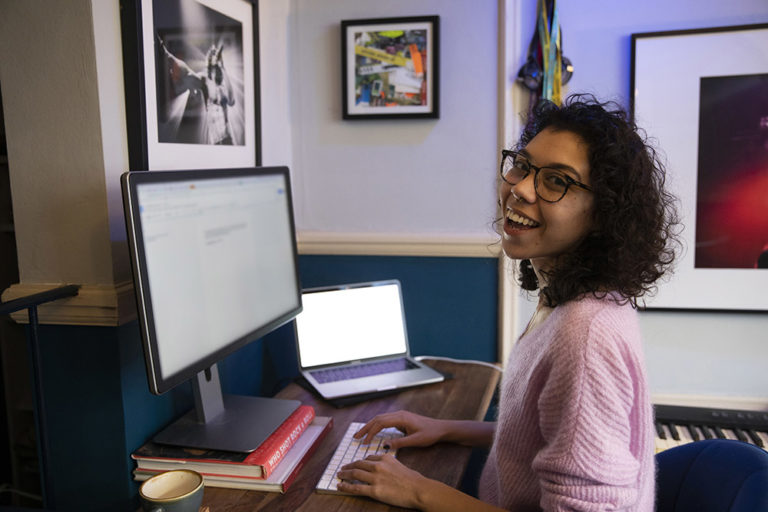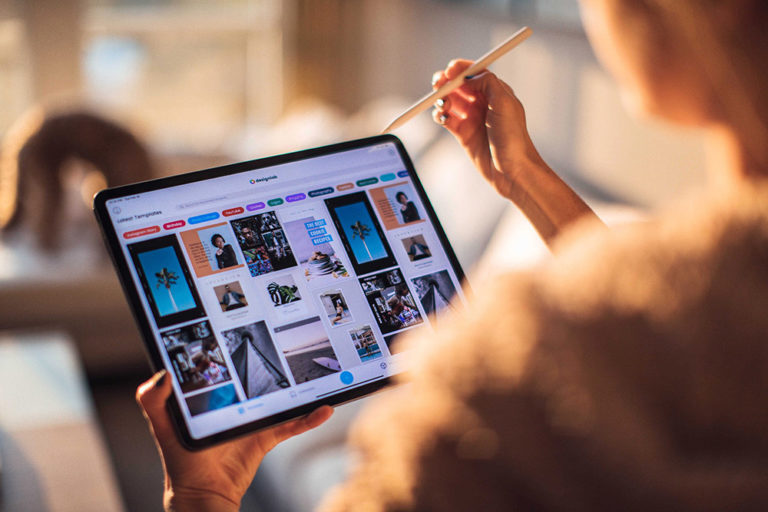What are the Top Website Design Trends for 2021?
We created a list of the top website design trends for 2021 based on extensive research carried out, into current and future consumer behavior.
In order to create our list, we analyzed 150 website designs. We looked and analyzed the following elements:
- Usability of the website – ease of navigation, user-friendly interface and how helpful it is to visitors.
- Visual innovation – stylishness, originality and visuals that are different from others. This should not be confused with design creativity, as it’s not the main purpose of a website.
- User experience innovation – how innovative is the way users interact with the design and what does it bring to their experience? – The effect this has on conversion rates should also be taken into consideration in order to rank sites correctly
The main goal was to find out the innovations that could influence websites over the next 2 years. These are the top website design trends for 2021 which we expect to see in web design within the next few years. Examine them carefully and if you can find something that can work
Live Content Experiences and Video Content Marketing
Video content marketing is increasingly on the rise, with 72% of businesses planning on using it in the next year.
Video Marketing is one of the best ways to transport your audience from one device to another, as well as giving them the chance to get more and more information about your business before they actually visit you. If done correctly, video marketing can also help a lot with SEO, but we’ll talk about that later.
It has strong appeal to a wide range of demographics in most countries and the only thing standing in its way is financial resources; nearly all businesses (99%) think the ROI of Video content Marketing is either good or excellent. This includes 93% of small businesses, with 70% planning to increase their budget for video marketing in 2020.
Video content can also be complemented with the use of live streaming, which is a new and exciting way to get people interested in your brand. Technology has caught up with this new demand, and companies are now able to provide high quality streaming services that are both secure (the main concern) and cheap. This makes them a force to be reckoned with when it comes to getting your message across within the video marketing realm, which will continue to be on the up and up throughout 2021, as well as in 2022.
Artificial Intelligence and Chatbots
Artificial intelligence has been slowly but surely creeping into our daily lives over the last few years and we can expect to see an even bigger presence of it in 2018. This is thanks to technologies such as Siri from Apple, Alexa from Amazon, Google Home all taking the world by storm. It’s also thanks to larger companies like Microsoft building AI assistants directly into their business ecosystems that help users interact with content in a new way. It is predicted that there will be over 60 billion devices using AI by the year 2021, which means it’s only going to get bigger, and a lot smarter over the next 3 years.
Optimizing Websites for Voice Search Queries
People are always on the move. Whether we’re working out, cooking dinner, or just lounging around, we’re always using our phones. This means that a lot of the searches done on Google are being done via voice search and not on the traditional keyboard search bar. You can see this for yourself by typing something into your search bar then seeing how it is said aloud by hitting “Say it” at the bottom of your screen. This means that you need to ensure that your website is optimized for voice search or else people searching on Google won’t be able to find you easily.
Paying Attention to User Behavior, with Personalization at the Forefront
People are now more aware of just how much their online experience can be tailored to suit their prior behavior and user habits. As a result, we can expect to see an emphasis placed on user experience in the future of web design. This will also mean that there will be a greater focus on personalization within your website. The technology for this is already here, it’s just a matter of integrating it into websites and allowing users to better control how much they want their online experience to be tailored around them.
A Push Towards Gestural Interfaces (Natural Language) or Touchscreen Capabilities (Haptics)
Swiping, pinching, and tapping have become second nature to most of us over the last few years. This means that we can expect to see a rise in websites that make use of natural language interfaces, or those that allow you to complete certain functions with gestures. A lot of this will be thanks to the development and growth of natural language processors, such as Siri, Alexa, Microsoft Cortana etc. More and more users are becoming familiar with how to interact with these devices, and our expectations of this type of functionality will grow in line with it. You can see this already implemented on sites like Slack where users can communicate using natural language commands such as “create a meeting between me and Adam for next Wednesday at 3pm”, without needing to memorize any specific syntax or keywords.
Expanding on 4K Resolution Videos and Film to Create a Unique User Experience
If you’ve seen any of the latest films in theaters or watched TV shows like Stranger Things, House of Cards or The Get Down on Netflix then you might have noticed that they are all being streamed with some beautiful cinematography. This is because there has been an increase in 4K UHD televisions and a desire for people to watch content that makes the most of them. You can also see this now being implemented on some websites, like Amazon that allows you to view certain 360 degree videos in full 4K resolution.
Better Usability of User Interface with Gestures and Touch Interfaces
With the increased popularity of mobile devices, we can expect to see an increase in websites that take advantage of touchscreens. This will allow users to get more out of their website than ever before. Haptic feedback and gestures are set to become increasingly popular and easier for developers to implement over the next 3 years as well.
This is only the tip of the iceberg when it comes to website design trends for 2021, though. The biggest changes will be in what we can expect from our websites and what they allow us to do. There are a lot of other things happening in technology that will set the stage for much stronger user experiences and interactions and it is only a matter of time before they are reflected in the world of design.
More Virtual Reality Experiences, Immersive Content and 4D Experiences
There has been a lot more hype about virtual reality recently with people like Facebook’s Mark Zuckerberg and Apple’s Tim Cook talking it up as the next big thing in personal computing. They’re not wrong, either. Virtual Reality is here to stay and over the next 3 years we can expect more and more people to adopt it as a way of using their computers and communicating with others online. This means that In addition to this, there’s also Augmented Reality which has seen a surge of interest thanks to developments in the world of mobile apps that utilize it, such as Pokemon Go. There’s also likely to be an increase in Virtual Reality and Augmented Reality based applications and content being used for marketing purposes.
The Next Trend in E-Commerce: Conversational Design and Conversational Commerce
Ever since we were first introduced to the Amazon Alexa, there have been some big predictions about where this type of technology is going. For anyone who has used one before will know that it can be pretty useful for setting alarms, controlling smart home devices and playing music. But what a lot of people don’t see is the potential that this technology has as a way of facilitating communication between customers and businesses.
Artistic Websites, Unique User Experiences
With a push towards unique user experiences and more immersive content we can expect to see a lot of web designers focusing more on creating artistic websites that have been carefully designed in order to appeal to the audience they’re trying to reach. This will be a challenge for almost everyone who works in the field, but it will make for some truly standout websites that are a pleasure to use and look at.
Design Focused on Mobile Devices
Already, responsive website design has made mobile optimization a priority for many web designers across the world, but this trend is set to continue as more internet users around the globe take advantage of the growing variety of mobile devices available to them. It is predicted that by 2021, the number of mobile devices in use will have risen from 2.9 billion to 4.7 billion or more. This will mean that a lot of attention must be paid to making sure that websites are optimized and look good on these screens, especially given the fact that many people now prefer to use their phones instead of desktop computers to get online.
Eye Tracking Screens and Holographic Displays
This is an interesting one as it’s not something that many people have thought about, but it’s definitely going to change the way we interact with screens both at home and in the office. Eye-tracking technology has been available before, but it was expensive because the screens needed to be equipped with specialist technologies.
Now though, mobile phone companies are looking to utilize it in a number of ways. It’s thought that this technology could become available on more and more mobile devices as the years progress.
Utilize AI and machine learning for developing customer-centric marketing campaigns, products, and services
As artificial intelligence increasingly becomes a part of our daily lives, it has started to spread into almost all aspects of the technology we use every day. This includes online marketing, especially search engine optimization and website design.
Because AI algorithms can learn from their mistakes faster than humans, they can be used for developing automated strategies that are more optimized to provide better and more targeted results. Another area that AI is likely to have an impact on in the next few years will be how businesses create content for websites and blogs. AI can also learn from human created entries and adapt them for better search engine optimization, which means that content creation could become a much easier process for web designers and businesses alike.
Dark Mode and Low Light UX Web Design Trends
A lot of people prefer to use their phones and mobile devices at night, so there is a growing demand for websites that are better suited towards low light conditions. The fact that OLED screens appear darker when displaying black makes designing such websites easier, but some web designers aren’t taking advantage of this unique property. In fact, some are even turning it into a way to provide better websites that function in low light conditions. This could make a massive difference for those who use their phones at night or on public transport. By 2022, it’s expected that at least 55% of all mobile devices will be equipped with OLED screens. It is therefore likely that more web designers will use dark modes and low light UX designs to take advantage of this growing trend.
Push towards micro-interactions
Websites will make a push towards incorporating more interactive features such as micro-interactions . Micro-interactions are small animations, sounds, or movements that can grab users’ attention and deliver information or even allow users to perform an action.
Better security
Websites will start improving their security features using more advanced encryption methods. This is a general trend that we’ve been seeing for the past few years and it is expected to continue in the coming years as well.
Improved navigation
Websites will start using gestures and improve their user interfaces (UI). For example, some websites will enable users to swipe left and right in order to browse through different sections of a website. Alternative solutions could also include touchscreen capabilities, such as the ability for content elements to be swiped or selected by hand. This would enable users to swipe between different sections of websites or content that are displayed on screen, without the need for a mouse or keyboard. This will definitely be interesting and useful in terms of user experience and usability.
Improved responsiveness
Websites will become more responsive, meaning that they can adapt to different screen resolutions and sizes. This is definitely a must-have in the current age of multiple devices, as users will expect websites to display correctly on all resolutions and screen sizes.
Accessibility and Availability
In future websites will start considering increasing accessibility and availability. For example, we could see the implementation of technologies that provide low-bandwidth access to websites. The idea here is not to restrict content for users with a faster internet connection, but rather present different levels of the same website depending on your device’s capabilities or connection speed.
Conclusion: The Future is Bright for Website Design
People often devalue the importance of design, but this is a mistake. Websites are how most of us interact and communicate with the world around us these days. As our lives become increasingly dependent on them, it’s important that they continue to improve in terms of design so as to better serve their users and facilitate great user experiences. 2020 was a good year for website design, with the adoption of responsive layouts and minimalist trends. This is likely to carry on into 2021 (and beyond!) and we can expect more websites that are clean, simple yet engaging.







